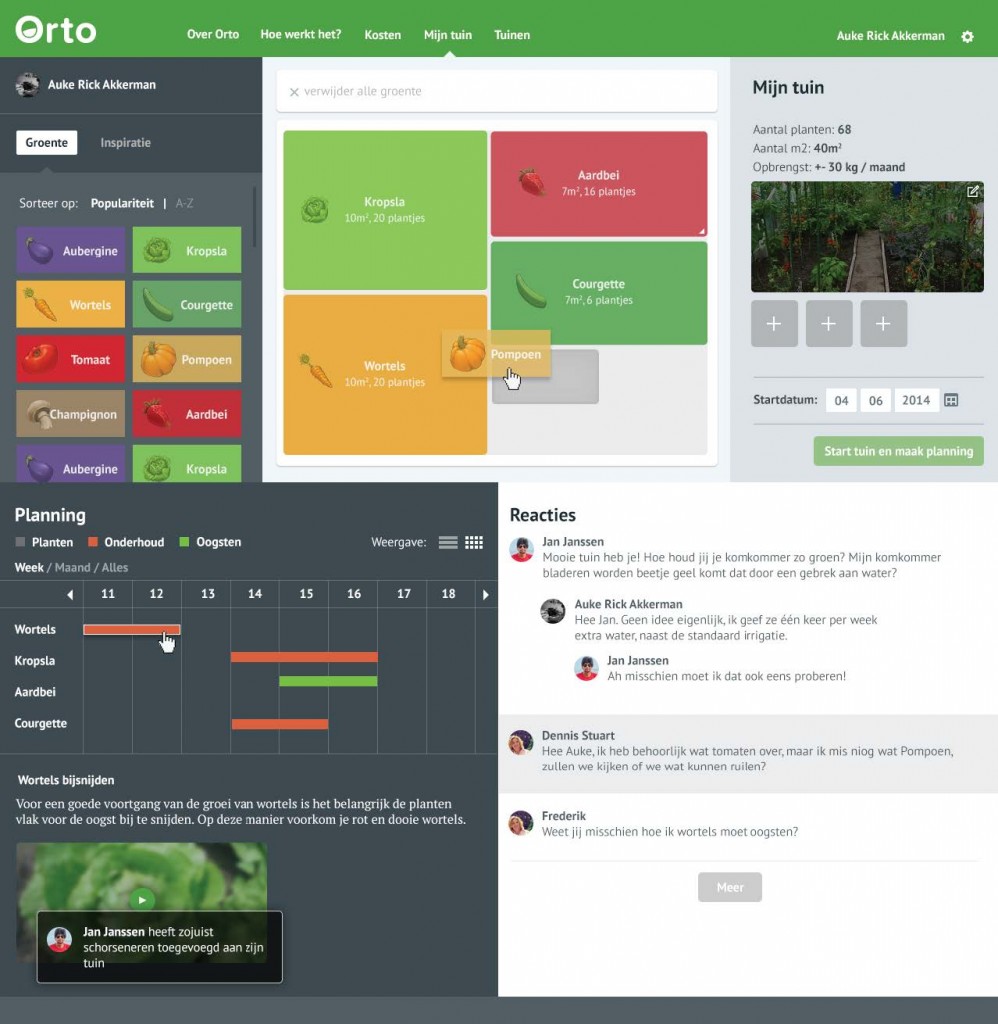Orto: a New Media solution for horticulturists
A small warning for the reader: This blogpost is not as theoretical as many of you may like it to be. Instead it offers a small case study exhibits the design and decisions of a project I did in order to show the use of New Media to solve a practical problem.
Food is a major problem. Ranging from high rates of obesity among kids to an unsustainable food production worldwide1, the problems surrounding our food consumption will change and determine our lives. Part of this issue can be seen in the enormous pressure the producers of our food face these days. Scaling in the agricultural industry has put smaller farmers and horticulturists out of business. Still today the latter are struggling to find a way to keep their greenhouses profitable. The rising energy prices combined with overproduction forces them to sell their product without profit. How can New Media help these producers and solve part of the food problem?
Shopping for food
New Media make connecting directly with a large number of people very easy. Offering your products to consumers directly using the advantages of the Internet would seem like an obvious solution. However, despite the enormous changes our world has seen over the past decades, people still buy their foods2 more or less the same way. Where in other industries online shopping and other online applications have thrived and are now largely accepted, the food industry is behind. This is largely due to three reasons3:
People are not ready to buy food online
Consumers want to smell, touch and feel the foods they buy. Even though the years and years of cultivation has left little of the original ‘qualities’ of vegetables, rendering the judgment of said food useless, people are hesitant to buy (raw) food online.
Distribution/logistics
The distribution of online product is something that is already difficult for a regular consumer product webshop. The limited shelf life of food complicates this situation even more.
People buy food the same day they eat it
For now this complicates the issue even more. However, in the near future we might see same day delivery as proposed for example by Amazon (Pierce). This will in my opinion stimulate the online buying of food.
So, what else is left?
Another possible solution to overcome the problems that horticulturists are facing is a pivot from being a large scale food producer to being a local service provider by transforming the greenhouse to a municipal garden. The demand for municipal gardens has increased over the last years (“Op de Wachtlijst Voor Een Volkstuin”). More people want to eat biological and sustainable vegetables. However, the horticulturists that experiment with this possibility still have a hard time making a living. People tend to not know what they are getting into when they start gardening. Most of them lack knowledge on planning, don’t know how to properly manage and/or take care of their plants. The time that is left for the horticulturist to help and support people with managing their garden proves to be too little. This results in a high turnover of people that signed up for a municipal garden.
Solution
These problems led me to develop Orto, a new type of municipal garden that uses a digital platform to support and inform its users. It eases users into the process of gardening as much as possible, helps them maintain a healthy garden, protects users from making easily avoidable mistakes and offers them a platform to discuss and improve each others gardens. The platform provides a lot of functionality, I will highlight the most important here.
Planning
Easy mistakes gardeners can make often lie in planning their garden. Both time and position are crucial when your goal is a good harvest. The platform offers an overview of the garden, as well as available vegetables that can be dragged and dropped onto the canvas, creating an easy way of planning your own garden. The platform provides a detailed calendar that shows where and what is required to guarantee an optimal harvest.
Contextual warnings
The application checks important issues such as plants that don’t go well together and suggests an optimal planning for the maintenance. Since plants don’t all grow in the same pace, the optimal moment for maintenance can differ.
Social interaction
The platform offers users the possibility to interact and share expertise with each other. Making use of photos and comments, the platform helps build a community and disburdens the professional horticulturist.
Conclusion
All in all the platform helps create a new way for horticulturists to maintain a profitable business and it provides amateur gardeners with an easy start up solution. The platform is now tailored to the needs of a greenhouse as a viable business. However, the benefits can easily be translated to a version that allows user to grow their food at home or in a municipal garden. Considering the current rate of food production/consumption and the limited resources of our planet, this might come in handy. I hope this case study shows how a technique that is perhaps the definition of technological progress can help solve very practical and worldly problems caused by the same progress.
1. For those interested in a thorough analysis of these problems I suggest “Food Security: The Challenge of Feeding 9 Billion People.” by H. Charles J. Godfray and others. (Godfray, H. Charles J. et al. “Food Security: The Challenge of Feeding 9 Billion People.” Science 327.5967 (2010): 812–818. www.sciencemag.org. Web. 7 Sept. 2014.)
“Op de Wachtlijst Voor Een Volkstuin.” TROUW. N. p., n.d. Web. 27 Feb. 2014.




